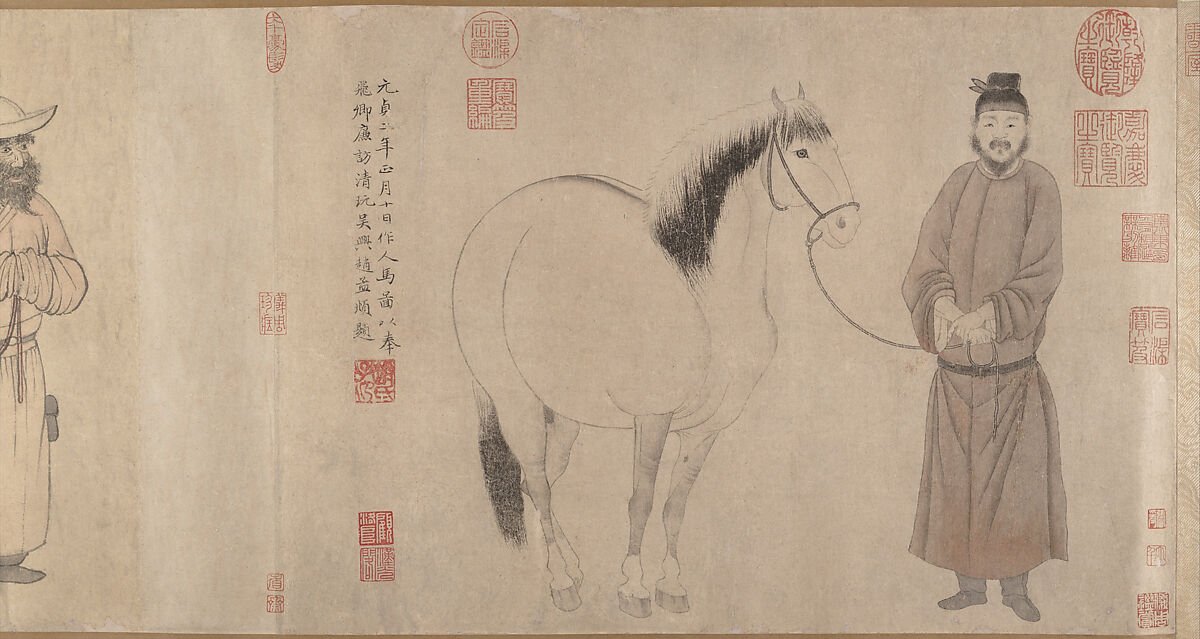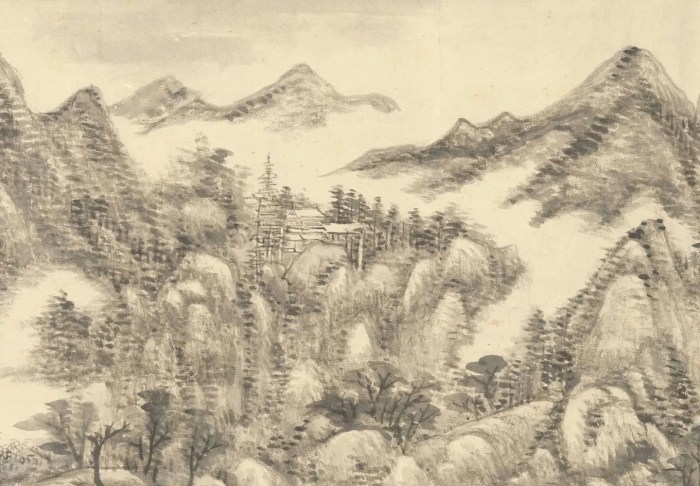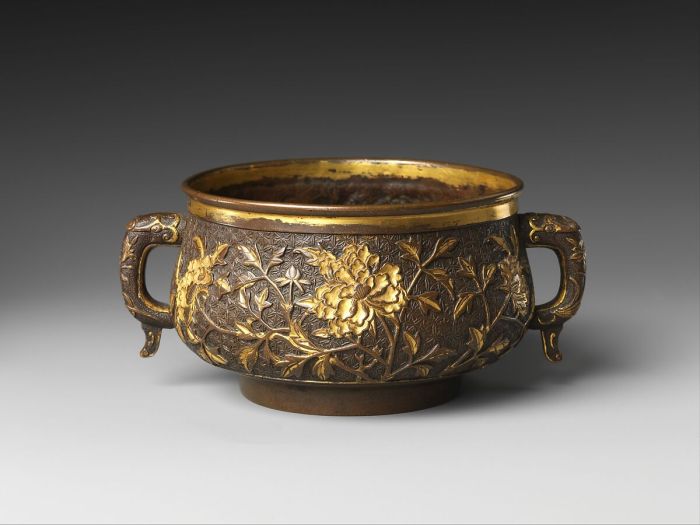Learning to paint in premodern China sets the stage for this enthralling narrative, offering readers a glimpse into a story that is rich in detail and brimming with originality from the outset. This comprehensive guide will explore the historical context, methods and techniques, major schools, themes and symbolism, and the profound influence of premodern Chinese painting on Western art.
Historical Context of Painting in Premodern China: Learning To Paint In Premodern China
The development of painting in premodern China spanned several centuries and was influenced by a complex interplay of cultural, philosophical, and religious factors. The earliest known Chinese paintings date back to the Neolithic period, around 10,000 BCE, and depict simple geometric designs and animal figures.
During the Shang dynasty (1600-1046 BCE), bronze vessels and ritual objects were often decorated with intricate designs that reflected the social and religious beliefs of the time.
The Warring States period (475-221 BCE) witnessed a significant advancement in painting techniques, with the introduction of ink and brush on silk. This period also saw the emergence of the first known Chinese painters, such as Zeuxis and Parrhasius, who were renowned for their ability to create realistic and lifelike images.
Confucianism and Painting
Confucianism, a philosophy that emphasized social harmony and moral conduct, had a profound influence on Chinese painting. Confucian scholars believed that painting could be used to convey moral messages and promote social order. This led to the development of a style of painting known as “literati painting,” which was characterized by its emphasis on simplicity, elegance, and scholarly refinement.
Taoism and Painting
Taoism, a philosophy that emphasized the importance of nature and spontaneity, also had a significant influence on Chinese painting. Taoist painters sought to capture the essence of nature through their work, using fluid brushstrokes and subtle colors to create a sense of harmony and balance.
Buddhism and Painting
Buddhism, a religion that originated in India, was introduced to China during the Han dynasty (206 BCE-220 CE). Buddhist art, which often depicted religious figures and scenes, had a significant impact on Chinese painting. Buddhist painters adopted many of the techniques and styles of Chinese painting, and their work helped to spread the Buddhist faith throughout China.
Calligraphy and Painting
Calligraphy, the art of writing Chinese characters, played an important role in Chinese painting. Many Chinese painters were also skilled calligraphers, and they often incorporated calligraphy into their paintings. The combination of calligraphy and painting created a unique and distinctive style that is characteristic of Chinese art.
Methods and Techniques of Premodern Chinese Painting
Premodern Chinese painting encompasses a vast array of methods and techniques that have evolved over centuries, showcasing the artistry and technical proficiency of Chinese painters. These methods include:
Brushwork
- Chinese painting emphasizes the use of brushes made from animal hair, with varying sizes and shapes for different effects.
- Brushwork techniques include dotting, dry brush, wet brush, and calligraphic strokes, each contributing to the expressive quality of the painting.
Ink
- Ink, derived from pine soot or other plant materials, is a fundamental element in Chinese painting.
- Ink is used to create a wide range of tones, from subtle washes to bold strokes, capturing the essence of subjects and evoking emotions.
Color
- While ink dominates Chinese painting, color is also employed to enhance the expressiveness and symbolism of the artwork.
- Mineral pigments, such as malachite and azurite, were traditionally used to create vibrant hues, each carrying specific meanings and associations.
Composition and Perspective
- Composition in Chinese painting follows principles of balance, harmony, and rhythm, often using asymmetrical arrangements to create visual interest.
- Perspective is employed in a unique way, with multiple viewpoints and spatial relationships depicted within a single painting.
Major Schools of Premodern Chinese Painting

The rich and diverse history of premodern Chinese painting encompasses various schools and styles, each characterized by unique aesthetic principles and techniques. These schools flourished during different periods of Chinese history and made significant contributions to the development of the art form.
Among the most influential schools are the Han, Tang, Song, Yuan, Ming, and Qing dynasties. Each school emerged during a specific historical period and reflected the cultural and aesthetic sensibilities of the time.
Han Dynasty, Learning to paint in premodern china
The Han dynasty (206 BCE – 220 CE) witnessed the emergence of early Chinese painting styles. Artists during this period focused on depicting scenes from daily life, historical events, and mythological tales. Han paintings were often executed on silk or paper scrolls and featured vibrant colors and dynamic compositions.
Representative Works:
- “Banquet at the Han Palace”
- “Lady Playing the Pipa”
Tang Dynasty
The Tang dynasty (618 – 907 CE) is considered a golden age of Chinese painting. Tang artists excelled in landscape painting, which became a major genre during this period. They developed a sophisticated technique known as “blue-and-green” painting, characterized by the use of vibrant blue and green pigments to create atmospheric landscapes.
Representative Works:
- “The Palace at Qingming Festival” by Zhang Zeduan
- “Landscape with Travelers” by Li Sixun
Song Dynasty
The Song dynasty (960 – 1279 CE) marked a further refinement of Chinese painting. Song artists emphasized the expression of literati ideals, focusing on the depiction of landscapes, flowers, and birds. They developed a subtle and atmospheric style characterized by the use of ink washes and brushwork.
Representative Works:
- “Listening to the Qin” by Gu Kaizhi
- “Dwelling in the Fuchun Mountains” by Huang Gongwang
Yuan Dynasty
The Yuan dynasty (1271 – 1368 CE) witnessed a departure from the literati styles of the Song dynasty. Yuan artists embraced a more expressive and individualistic approach, often depicting scenes of nature with bold brushwork and vibrant colors.
Representative Works:
- “Water Buffaloes” by Zhao Mengfu
- “Ten Thousand Miles of the Yangtze River” by Wang Meng
Ming Dynasty
The Ming dynasty (1368 – 1644 CE) saw a revival of interest in classical painting styles. Ming artists sought to emulate the masters of the Tang and Song dynasties, focusing on the depiction of landscapes and flowers. They also developed new techniques, such as the use of “boneless” painting, which created a soft and ethereal effect.
Representative Works:
- “A Thousand Li of Rivers and Mountains” by Wang Hui
- “The Plum Blossom in the Snow” by Chen Hongshou
Qing Dynasty
The Qing dynasty (1644 – 1912 CE) was the last imperial dynasty of China. Qing painting continued the traditions of the Ming dynasty but also incorporated new influences, such as Western painting techniques. Qing artists excelled in a wide range of styles, from realistic landscapes to delicate flower paintings.
Representative Works:
- “Ascending the Mountain in Autumn” by Dong Qichang
- “Lotus and Mandarin Ducks” by Giuseppe Castiglione
Themes and Symbolism in Premodern Chinese Painting

Premodern Chinese painting is renowned for its rich symbolism and allegorical elements, which imbued artworks with profound cultural and religious significance. Common themes explored in these paintings included nature, landscapes, figures, and mythical creatures.Nature was a central theme, often depicted in landscapes that symbolized harmony between humans and the natural world.
Mountains, rivers, and trees were imbued with spiritual significance, representing strength, longevity, and growth. Landscapes also served as metaphors for the human journey, with winding paths and distant peaks evoking the challenges and aspirations of life.Figures were another common theme, often portrayed in scenes of daily life, historical events, or religious narratives.
Emperors, scholars, and deities were depicted with meticulous detail, their clothing, gestures, and expressions conveying their status and character. Figures were often placed within landscapes, creating a harmonious interplay between the human and natural realms.Mythical creatures, such as dragons, phoenixes, and unicorns, also played a significant role in Chinese painting.
These creatures were believed to possess supernatural powers and were often associated with specific virtues or qualities. Dragons symbolized strength, wisdom, and protection, while phoenixes represented beauty, grace, and immortality.Symbolism was extensively used in Chinese painting to convey complex ideas and emotions.
The color red, for example, was associated with joy, prosperity, and good fortune, while black represented darkness, evil, and mourning. Flowers, animals, and plants also carried specific meanings, such as the lotus flower symbolizing purity and enlightenment, and the bamboo representing resilience and adaptability.Allegory
was another important aspect of Chinese painting, where objects and scenes were used to convey hidden meanings or moral lessons. For instance, a painting of a crane flying over a pine tree might symbolize the pursuit of longevity and immortality, while a scene of a fisherman on a boat could represent the search for enlightenment or inner peace.The
cultural and religious significance of symbols and motifs in Chinese painting was profound. Many symbols were rooted in ancient myths and legends, while others were influenced by Buddhist, Taoist, and Confucian beliefs. The use of symbolism allowed artists to express complex ideas and emotions that could not be easily conveyed through words alone, creating a rich and nuanced visual language that continues to captivate viewers to this day.
Influence of Premodern Chinese Painting on Western Art

The influence of premodern Chinese painting on Western art is a complex and multifaceted phenomenon that spans centuries and continents. Chinese painting techniques, aesthetics, and subject matter have all left a lasting impression on European and American art, particularly during the 19th and 20th centuries.
One of the most significant ways in which Chinese painting influenced Western art was through the introduction of new techniques and materials. Chinese artists had developed a wide range of painting techniques, including the use of ink and brush, silk and paper, and mineral pigments.
These techniques were adopted by Western artists, who were eager to experiment with new ways of creating art.
Impact on European Artists
The impact of Chinese painting on European artists was particularly evident in the work of Vincent van Gogh and Pablo Picasso. Van Gogh was fascinated by the expressive power of Chinese brushwork, and he incorporated elements of Chinese painting into his own work.
Picasso was also influenced by Chinese painting, particularly by the way in which Chinese artists used line and form to create a sense of space and depth.
Role in Modern Art
Chinese painting also played a role in the development of modern art. In the early 20th century, many Western artists began to reject the traditional conventions of Western painting and to look for new sources of inspiration. Chinese painting, with its emphasis on spontaneity and expression, was a major influence on these artists.
FAQ Corner
What were the major influences on premodern Chinese painting?
Confucianism, Taoism, and Buddhism were the major philosophical and religious influences that shaped the development of premodern Chinese painting.
What is the significance of calligraphy in Chinese painting?
Calligraphy is an integral part of Chinese painting, and the ability to write Chinese characters with skill and grace was considered an essential skill for painters.
What are the common themes found in premodern Chinese painting?
Common themes in premodern Chinese painting include landscapes,人物画(figure painting),花鸟画(bird-and-flower painting), and religious subjects.